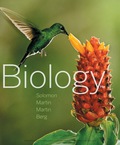
Concept explainers
Population _______________ is the number of individuals of a species per unit of habitat area or volume at a given time. (a) dispersion (b) density (c) survivorship (d) age structure (e) demographics
Introduction: The study of change in population is termed as population dynamics. Population ecology can be defined as both the number of individuals for a particular species in an area and dynamics of the population. It is the study of interaction of population with the environment, such as competition of individuals for food and other resources.
Answer to Problem 1TYU
Correct answer: At a given time, the number of individuals of a species per unit of habitat area is described as population density.
Hence, the correct answer is option (b).
Explanation of Solution
Reason for the correct answer:
The population density of a particular area refers to as the number of individuals of a species per unit volume or habitat area at a particular time. Population density varies according to the time of year and type of the environment. Population density of an area can also vary according to the different season.
Option (b) is given as “density”.
The number of individuals of a species per unit habitat volume at a given time is known as population density. Hence, option (b) is correct.
Reasons for incorrect answers:
Option (a) is given as “dispersion”.
Population dispersion is described as the movement of individuals from one population to another population. It shows the migration rate of a population. Hence, option (a) is incorrect.
Option (c) is given as “survivorship”.
Survivorship gives the probability about the survival of an individual at a certain age. It does not tell about the number of individuals per unit volume. Hence, option (c) is incorrect.
Option (d) is given as “age structure”.
Age structure is the proportion of individuals at each age; therefore, it does not tell about the number of individuals per unit habitat area. Hence, option (d) is incorrect.
Option (e) is given as “demographics”.
Population demographics are statistics related to human population and does not tell about the number of individuals of a species per unit volume at a given time. Hence, option (e) is incorrect.
Hence, options (a), (c), (d), and (e) are incorrect.
The total number of individuals of a specific species per unit habitat area at a given time is described as the population density of that species.
Want to see more full solutions like this?
Chapter 53 Solutions
EBK BIOLOGY
Additional Science Textbook Solutions
Biological Science (6th Edition)
College Physics: A Strategic Approach (3rd Edition)
EBK INTRODUCTION TO CHEMISTRY
Laboratory Manual For Human Anatomy & Physiology
SEELEY'S ANATOMY+PHYSIOLOGY
Biology: Life on Earth with Physiology (11th Edition)
- CUÁ Glycine A C C Newly formed molecule Glycine Arginine Proline Alanine A C C CC G GGAUUGGUGGGGC Structure X I mRNAarrow_forwardAdaptations to a Changing Environment Why is it necessary for organisms to have the ability to adapt? Why is the current environment making it difficult for organisms like the monarch butterfly to adapt? Explain how organisms develop adaptations.arrow_forwardArtificial Selection: Explain how artificial selection is like natural selection and whether the experimental procedure shown in the video could be used to alter other traits. Why are quail eggs useful for this experiment on selection?arrow_forward
- Don't give AI generated solution otherwise I will give you downwardarrow_forwardHello, Can tou please help me to develope the next topic (in a esquematic format) please?: Function and Benefits of Compound Microscopes Thank you in advance!arrow_forwardIdentify the AMA CPT assistant that you have chosen. Explain your interpretation of the AMA CPT assistant. Explain how this AMA CPT assistant will help you in the future.arrow_forward
- Fitness 6. The primary theory to explain the evolution of cooperation among relatives is Kin Selection. The graph below shows how Kin Selection theory can be used to explain cooperative displays in male wild turkeys. B When paired, subordinant males increase the reproductive success of their solo, dominant brothers. 0.9 C 0 Dominant Solo EVOLUTION Se, Box 13.2 © 2023 Oxford University Press rB rB-C Direct Indirect Fitness fitness fitness gain Subordinate 19 Fitness After A. H. Krakauer. 2005. Nature 434: 69-72 r = 0.42 Subordinant Dominant a) Use Hamilton's Rule to show how Kin Selection can support the evolution of cooperation in this system. Show the math. (4 b) Assume that the average relatedness among male turkeys in displaying pairs was instead r = 0.10. Could kin selection still explain the cooperative display behavior (show math)? In this case, what alternative explanation could you give for the behavior? (4 pts) 7. In vampire bats (pictured below), group members that have fed…arrow_forwardExamine the following mechanism and classify the role of each labeled species in the table below. Check all the boxes that applyarrow_forward1. Define and explain the two primary evolutionary consequences of interspecific competitionarrow_forward
 Human Anatomy & Physiology (11th Edition)BiologyISBN:9780134580999Author:Elaine N. Marieb, Katja N. HoehnPublisher:PEARSON
Human Anatomy & Physiology (11th Edition)BiologyISBN:9780134580999Author:Elaine N. Marieb, Katja N. HoehnPublisher:PEARSON Biology 2eBiologyISBN:9781947172517Author:Matthew Douglas, Jung Choi, Mary Ann ClarkPublisher:OpenStax
Biology 2eBiologyISBN:9781947172517Author:Matthew Douglas, Jung Choi, Mary Ann ClarkPublisher:OpenStax Anatomy & PhysiologyBiologyISBN:9781259398629Author:McKinley, Michael P., O'loughlin, Valerie Dean, Bidle, Theresa StouterPublisher:Mcgraw Hill Education,
Anatomy & PhysiologyBiologyISBN:9781259398629Author:McKinley, Michael P., O'loughlin, Valerie Dean, Bidle, Theresa StouterPublisher:Mcgraw Hill Education, Molecular Biology of the Cell (Sixth Edition)BiologyISBN:9780815344322Author:Bruce Alberts, Alexander D. Johnson, Julian Lewis, David Morgan, Martin Raff, Keith Roberts, Peter WalterPublisher:W. W. Norton & Company
Molecular Biology of the Cell (Sixth Edition)BiologyISBN:9780815344322Author:Bruce Alberts, Alexander D. Johnson, Julian Lewis, David Morgan, Martin Raff, Keith Roberts, Peter WalterPublisher:W. W. Norton & Company Laboratory Manual For Human Anatomy & PhysiologyBiologyISBN:9781260159363Author:Martin, Terry R., Prentice-craver, CynthiaPublisher:McGraw-Hill Publishing Co.
Laboratory Manual For Human Anatomy & PhysiologyBiologyISBN:9781260159363Author:Martin, Terry R., Prentice-craver, CynthiaPublisher:McGraw-Hill Publishing Co. Inquiry Into Life (16th Edition)BiologyISBN:9781260231700Author:Sylvia S. Mader, Michael WindelspechtPublisher:McGraw Hill Education
Inquiry Into Life (16th Edition)BiologyISBN:9781260231700Author:Sylvia S. Mader, Michael WindelspechtPublisher:McGraw Hill Education





